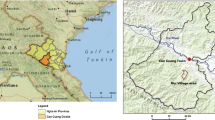Abstract
This study assesses potential effects of adaption to climate change in the future as a carbon related value using a baseline and credit approach, considering the implementation of the Reducing Emissions from Deforestation and forest Degradation (REDD) mechanism. Basic data were obtained for implementing the REDD mechanism in the Democratic People’s Republic of Korea (DPRK) for scientific decision-making to prevent deforestation and forest degradation. The potential effects according to the implementation of the REDD mechanism in the DPRK based on forest status data (the latest) are as follows. If the deforestation rate is reduced to a level below 6% through a 20-year REDD mechanism beginning in 2011, 0.01–11.64 C-tons of carbon credit per ha could be issued for DPRK. Converted into CO2-tons per ha, this amounts to 0.03–42.68 CO2-tons, which translates to a minimum of 226,000 CO2-tons and a maximum of 289,082,000 CO2-tons overall for forests in DPRK. In terms of carbon price, this measures up to 1.10 million USD–1.4 billion USD, considering that the REDD carbon price in voluntary carbon markets in 2010 was around 5 USD.
Similar content being viewed by others
References
Bae JS (2013) A preliminary review of REDD Mechanism for rehabilitating forest degradation of North Korea. Seoul, South Korea. Journal of Korean Forest Society 102(4): 491–498. (In Korean with English abstract). DOI: 10.14578/jkfs.2013.102.4.491
Burck J, Bals C, Beck M, et al. (2008) The Climate Change Performance Index: a comparison of emissions trends and climate protection policies of the top 56 CO2 emitting nations. Germanwatch. p 20. Available online at: http: //germanwatch.org/klima/ccpi08.pdf (Accessed on 16 July 2015)
FAO (Food and Agriculture of the United Nations) (2010) Global Forest Resources Assessment 2010. Country Report: The Democratic People’s Republic of Korea. FRA2010/053. Rome, Italy. FAO. p 37. (In English) Available online at: http: //www.fao.org/docrep/013/al489E/al489e.pdf (Accessed on 16 July 2015).
Harmeling S, Eckstein D (2013) Global climate risk index 2013: who suffers most from extreme weather events? Weather-related loss events in 2011 and 1992 to 2011. Germanwatch Briefing Paper. p 28. Available online at: https: //germanwatch.org/en/download/7170.pdf (Accessed on 16 July 2015)
Joanneum Research, Union of Concerned Scientists, Woods Hole Research Center, et al. (2006) Reducing emissions from deforestation in developing countries: potential policy approaches and positive incentives. UNFCCC/SBSTA/2006/L.25. p 14. Available online at: http: //www.ipam.org.br/download/livro/Reducao-de-Emissoes-de-Desmatamento-em-Paises-em-Desenvolvimento/203 (Accessed on 16 July 2015)
Jo JH (2012) Economic feasibility of REDD project for preventing deforestation in North Korea. Master thesis, Seoul National University. Seoul, South Korea. p 78.
KFRI (Korea Forest Research Institute) (2011) Carbon emission factor for forest GHGs inventory. KFRI, Seoul, South Korea. p 107.(In Korean)
Lee SH (2004) Situation of Degraded Forest Land in DPRK and Strategies for Forestry Cooperation between South and North Korea. Journal Korea. Journal of Agriculture & Life Sciences 38(3): 37–48. (In Korean with English abstract)
Leischner B, Elsasser P (2010) Reference emission level for REDD: Implications of four different approaches applied to past period’s forest area development in 84 countries. Braunschweig, Germany. Landbauforschung vTI Agriculture and Forestry Research 60(3): 119–130.
Mollicone D, Achard F, Federici S, et al. (2007) An incentive mechanism for reducing emissions from conversion of intact and non-intact forests. Climate Change 83(4): 477–493. DOI: 10.1007/s10584-006-9231-2
Oh YC (2012) A Study on A/R CDM Application for the Forestation and Deforested Land in North Korea. Master thesis. Seoul National University, Seoul, South Korea. p 79. (In Korean)
Parker C, MitchellA, TrivediM, et al. (2009) The little REDD+ book: an updated guide to governmental and non-governmental proposals for reducing emissions from deforestation and degradation. Global Canopy Programme, Oxford, UK. pp 60–70. (In English)
Park KS, Lee SY, Park SY (2011) A study on the basic directions for forest rehabilitation programs considering to economic and social conditions of North Korea. Seoul, South Korea. Journal of Korean Forestry Society 100(3): 423–431. (In Korean with English abstract)
Park HC, Oh CH (2012) A Study of baseline approach for implementing program of reduced emissions from deforestation and forest degradation in South Korea. Korean Journal of Environment and Ecology 26(4): 484–497. (In Korean with English abstract)
Park HC, Oh CH (2014a) A Study on analysis of the suitable sites to implement REDD+ program and plan of activation in South Korea. Seoul, South Korea. Korean Journal of Environment and Ecology 28(2): 171–181. (In Korean with English abstract). DOI: 10.13047/KJEE.2014.28.2.171
Park HC, Oh CH (2014b) A study on effect of carbon dioxide emission reduction through use of harvested wood products counteracting deforestation. Seoul, South Korea. Korean Journal of Association for the Study of Literature & Environment 13(1): 109–127. (In Korean with English abstract)
Santilli M, Moutinho P, Schwartzman S, et al. (2005) Tropical deforestation and the Kyoto Protocol: an editorial essay. Climate Change 71(3): 267–276. DOI: 10.1007/s10584-005-8074-6
UNFCCC (United Nations Framework Convention on Climate Change) (2005) Decision 16/CMP.1 on Land use, land-use change and forestry. FCCC/KP/CMP/2005/8/Add.3. p 7.(In English). Available online at: http: //www.redd-monitor.org/wpcontent/uploads/2009/09/Kyoto_COP001_016.pdf (Accessed on 16 July 2015)
UNFCCC (United Nations Framework Convention on Climate Change) (2007) Reducing emissions from deforestation in developing countries and approaches to stimulate action. Report of the Conference of the Parties on its thirteenth session, held in Bali from 3 to 15 December 2007. Part Two: Action taken by the Conference of the Parties at its thirteenth session. FCCC/CP/2007/6/Add.1. Decision 2/CP.13 pp 8–11. Available online at: http://unfccc.int/resource/docs/2007/cop13/eng/06a01.pdf. (Accessed on 16 July 2015).
Author information
Authors and Affiliations
Corresponding author
Additional information
http://orcid.org/0000-0002-1685-9464
http://orcid.org/0000-0002-8512-9641
Rights and permissions
About this article
Cite this article
Park, H.C., Oh, C.H. Potential effects of future adoption of the REDD mechanism as a preventive measure against deforestation and forest degradation in North Korea. J. Mt. Sci. 13, 1645–1651 (2016). https://doi.org/10.1007/s11629-014-3300-1
Received:
Revised:
Accepted:
Published:
Issue Date:
DOI: https://doi.org/10.1007/s11629-014-3300-1




